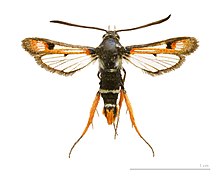| Sesioidea | |
|---|---|

| |
| Pyropteron chrysidiforme - Sesioidea | |
| Scientific classification | |
| Domain: | Eukaryota |
| Kingdom: | Animalia |
| Phylum: | Arthropoda |
| Class: | Insecta |
| Order: | Lepidoptera |
| Clade: | Macroheterocera |
| Superfamily: | Sesioidea |
| Families | |
| Diversity | |
| over 1,300 species | |
Sesioidea is a superfamily containing clearwing moths (Sesiidae), castniid moths (Castniidae) and little bear moths (Brachodidae). [1][2] There is evidence from head and thoracic morphology that the first two families, internally feeding in plants as caterpillars, are sisters, whilst some brachodids are known to feed on leaf surfaces (Edwards et al., 1999). Sesioidea is closely related to Cossoidea, which contains the also internal-feeding Goat and Leopard moths, and recent taxonomic treatments consider the sessoid families as part of Cossoidea sensu lato.[3][4]
References
[edit]- ^ Edwards, Edward D.; Gentili, Patricia; Horak, Marianne; Kristensen, Niels P.; Nielsen, Ebbe S. (1998). "11. The Cossoid/Sesioid Assemblage". Band 4: Arthropoda, 2 Hälfte: Insecta, Lepidoptera, Moths and Butterflies, Teilband/Part 35, Volume 1: Evolution, Systematics, and Biogeography. doi:10.1515/9783110804744.181. ISBN 9783110804744.
- ^ O'Toole, Christopher, ed. (2002). Firefly Encyclopedia of Insects and Spiders. Firefly Books. ISBN 978-1-55297-612-8.
- ^ van Nieukerken, Erik J.; Kaila, Lauri; Kitching, Ian J.; Kristensen, Niels P.; Lees, David C.; Minet, Joël; Mitter, Charles; Mutanen, Marko; Regier, Jerome C.; Simonsen, Thomas J.; Wahlberg, Niklas; Yen, Shen-Horn; Zahiri, Reza; Adamski, David; Baixeras, Joaquin; Bartsch, Daniel; Bengtsson, Bengt Å.; Brown, John W.; Bucheli, Sibyl Rae; Davis, Donald R.; De Prins, Jurate; De Prins, Willy; Epstein, Marc E.; Gentili-Poole, Patricia; Gielis, Cees; Hättenschwiler, Peter; Hausmann, Axel; Holloway, Jeremy D.; Kallies, Axel; Karsholt, Ole; Kawahara, Akito Y.; Koster, Sjaak (J.C.); Kozlov, Mikhail V.; Lafontaine, J. Donald; Lamas, Gerardo; Landry, Jean-François; Lee, Sangmi; Nuss, Matthias; Park, Kyu-Tek; Penz, Carla; Rota, Jadranka; Schintlmeister, Alexander; Schmidt, B. Christian; Sohn, Jae-Cheon; Solis, M. Alma; Tarmann, Gerhard M.; Warren, Andrew D.; Weller, Susan; Yakovlev, Roman V.; Zolotuhin, Vadim V.; Zwick, Andreas (23 December 2011). Zhang, Zhi-Qiang (ed.). "Order Lepidoptera Linnaeus, 1758" (PDF). Zootaxa. Animal biodiversity: An outline of higher-level classification and survey of taxonomic richness. 3148: 212–221.
- ^ Mitter, Charles; Davis, Donald R.; Cummings, Michael P. (2017). "Phylogeny and Evolution of Lepidoptera". Annual Review of Entomology. 62: 265–283. doi:10.1146/annurev-ento-031616-035125. PMID 27860521.
Well, that’s interesting to know that Psilotum nudum are known as whisk ferns. Psilotum nudum is the commoner species of the two. While the P. flaccidum is a rare species and is found in the tropical islands. Both the species are usually epiphytic in habit and grow upon tree ferns. These species may also be terrestrial and grow in humus or in the crevices of the rocks.
View the detailed Guide of Psilotum nudum: Detailed Study Of Psilotum Nudum (Whisk Fern), Classification, Anatomy, Reproduction